Managing offshore teams from the U.S. requires balancing time zones, clear communication, and cultural understanding. This 2025 guide covers why American companies leverage offshore talent, challenges like time differences and collaboration hurdles, and actionable best practices (from using the right tools to fostering trust) to help U.S. managers build high-performing global development teams.
A Complete Guide for Best Practices for Managing Offshore Teams from the U.S.
In this comprehensive guide, we’ll explore why U.S. companies rely on offshore teams, the key challenges and offshore team management best practices, and proven strategies to turn a dispersed group into a unified, high-performing unit.
Imagine it’s 9 AM in New York. Your engineers in California are just starting their day, while your QA tester in Poland is midway through the afternoon, and a developer in India is logging off for the night.
Welcome to managing offshore teams as a U.S. company in 2025. This has become the norm for countless American businesses striving to stay competitive in a global talent market.
Working with distributed teams across continents can unlock around-the-clock productivity and cost efficiencies, but it also introduces challenges – from time zone gaps and cultural nuances to maintaining team cohesion.
Read: Offshore vs Nearshore
Why U.S. Companies Rely on Offshore Teams
U.S. companies – from lean startups to Fortune 500 giants – increasingly rely on offshore development partners to scale their capabilities. The reasons are compelling:

1. Access to Global Talent
The demand for skilled software developers in the U.S. far exceeds local supply. Offshoring opens access to a worldwide talent pool, allowing companies to tap specialized skills in tech hubs from India to Eastern Europe.
In fact, India remains the top global outsourcing destination for IT talent. Countries like Ukraine (over 200,000 IT workers) are also emerging as major tech talent centers. This global reach helps U.S. firms fill critical skill gaps quickly.
2. Cost Efficiency
Labor and operational costs can be significantly lower in many offshore regions compared to U.S. metropolitan areas. It’s no surprise that 59% of companies outsource specifically to cut costs.
By using skilled developers from areas with lower costs of living, U.S. businesses can reduce development expenses without sacrificing quality. This cost savings can be reallocated to innovation or marketing, giving companies a competitive edge.
3. Around-the-Clock Productivity
With teams spread across time zones, work literally continues 24/7. A U.S. team can hand off tasks at day’s end to their counterparts in Asia or Europe who are just starting their workday. This “follow-the-sun” model accelerates development cycles and customer support.
For example, a bug discovered late afternoon in Chicago can be fixed by developers in Bangalore overnight and be ready by the next U.S. morning. Such agility in response time is a strategic advantage in fast-paced industries.
4. Focus on Core Business
Offloading certain development or IT functions to an offshore development partner allows U.S. companies to focus on core competencies. Instead of stretching your in-house team thin with secondary projects, you can delegate those to a trusted offshore team.
This is reflected in statistics: besides cost savings, 57% of businesses outsource to enable focus on their core business activities. In other words, offshoring frees up your domestic team to prioritize strategic, high-value work.
5. Scalability and Flexibility
Offshore teams provide on-demand scalability. Need 5 more developers for a new feature? An offshore partner can ramp up a team quickly. Conversely, you can scale down after project completion without the hurdles of local hiring or layoffs.
This flexibility helps U.S. firms adapt to market changes swiftly. It’s telling that more than 65% of companies that have outsourced before plan to increase outsourcing, having seen the benefits firsthand.
It’s clear why so many American organizations—from Silicon Valley startups to established enterprises—embrace offshore collaboration. In fact, the U.S. accounts for over 84% of global outsourcing deals by value, illustrating how central U.S. companies are in the offshoring landscape. However, along with the benefits come real challenges that managers must skillfully navigate.
Pros and Cons of Managing Offshore Teams for U.S. Companies
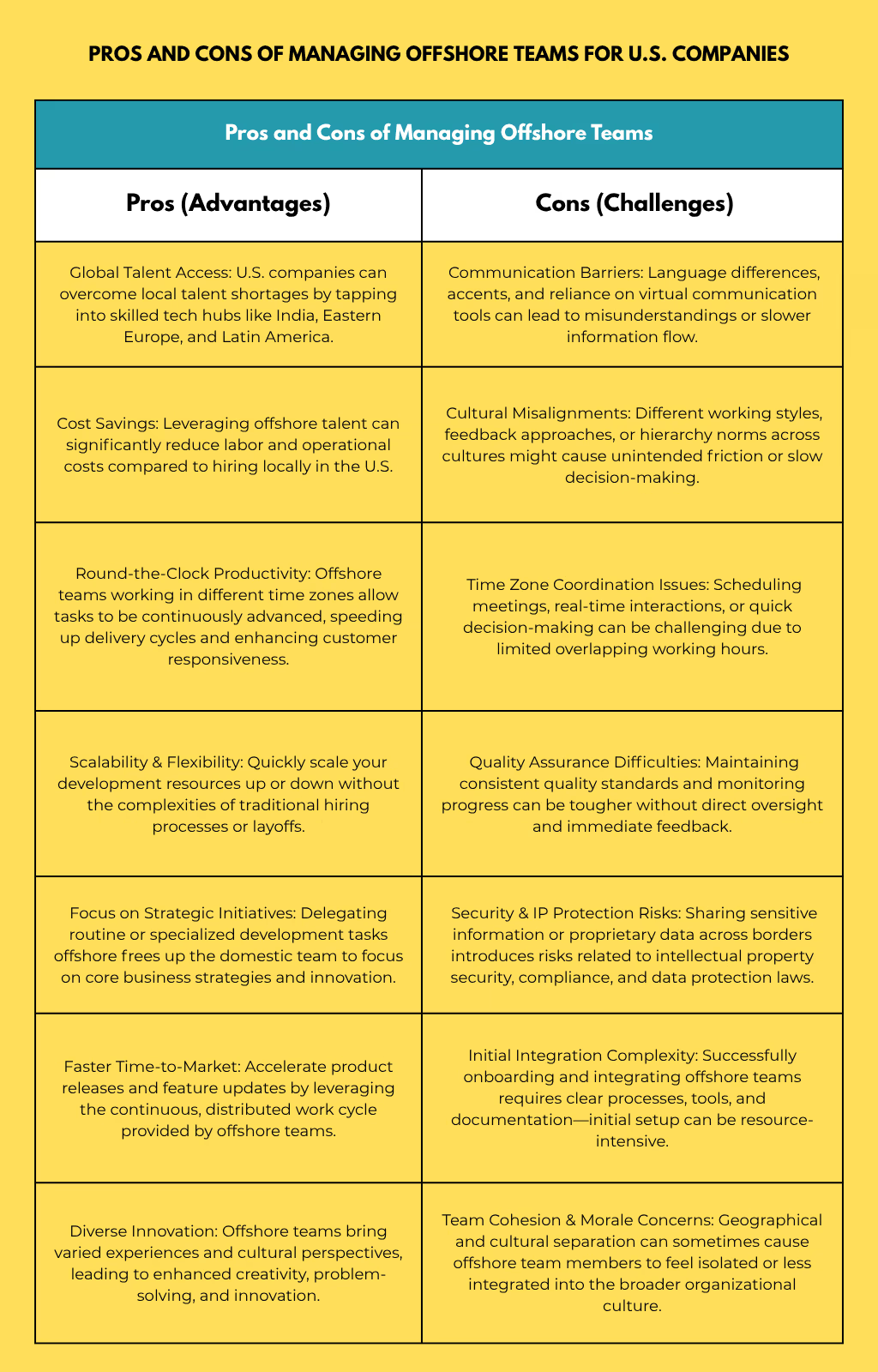
👉 Ready to Build a High-Performing Offshore Team?
Whether you're managing distributed developers or seeking a trusted offshore development partner in India, Decipher Zone can help you scale faster, smarter, and at lower cost.
|
Pros and Cons of Managing Offshore Teams | |
|
Pros (Advantages) |
Cons (Challenges) |
|
Global Talent Access: U.S. companies can overcome local talent shortages by tapping into skilled tech hubs like India, Eastern Europe, and Latin America. |
Communication Barriers: Language differences, accents, and reliance on virtual communication tools can lead to misunderstandings or slower information flow. |
|
Cost Savings: Leveraging offshore talent can significantly reduce labor and operational costs compared to hiring locally in the U.S. |
Cultural Misalignments: Different working styles, feedback approaches, or hierarchy norms across cultures might cause unintended friction or slow decision-making. |
|
Round-the-Clock Productivity: Offshore teams working in different time zones allow tasks to be continuously advanced, speeding up delivery cycles and enhancing customer responsiveness. |
Time Zone Coordination Issues: Scheduling meetings, real-time interactions, or quick decision-making can be challenging due to limited overlapping working hours. |
|
Scalability & Flexibility: Quickly scale your development resources up or down without the complexities of traditional hiring processes or layoffs. |
Quality Assurance Difficulties: Maintaining consistent quality standards and monitoring progress can be tougher without direct oversight and immediate feedback. |
|
Focus on Strategic Initiatives: Delegating routine or specialized development tasks offshore frees up the domestic team to focus on core business strategies and innovation. |
Security & IP Protection Risks: Sharing sensitive information or proprietary data across borders introduces risks related to intellectual property security, compliance, and data protection laws. |
|
Faster Time-to-Market: Accelerate product releases and feature updates by leveraging the continuous, distributed work cycle provided by offshore teams. |
Initial Integration Complexity: Successfully onboarding and integrating offshore teams requires clear processes, tools, and documentation—initial setup can be resource-intensive. |
|
Diverse Innovation: Offshore teams bring varied experiences and cultural perspectives, leading to enhanced creativity, problem-solving, and innovation. |
Team Cohesion & Morale Concerns: Geographical and cultural separation can sometimes cause offshore team members to feel isolated or less integrated into the broader organizational culture. |
Key Challenges in Managing Offshore Teams from USA
Despite the advantages, managing an offshore team from the U.S. isn’t without its hurdles. Let’s acknowledge the challenges of managing offshore teams so we can address them head-on:
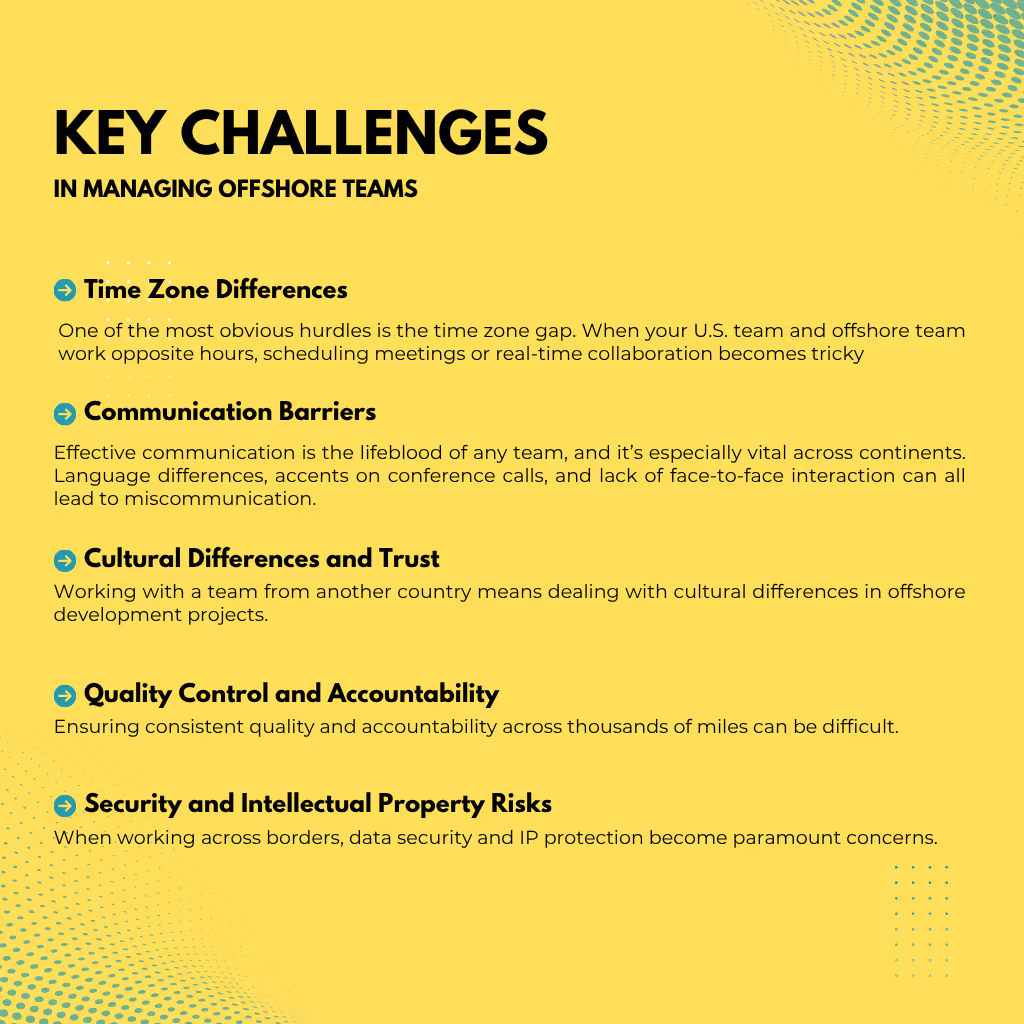
1. Time Zone Differences
One of the most obvious hurdles is the time zone gap. When your U.S. team and offshore team work opposite hours, scheduling meetings or real-time collaboration becomes tricky. Critical questions can languish for half a day awaiting an answer from across the globe.
It’s a common pain point – in a recent remote work survey, 14% of respondents cited “working across time zones” as their biggest struggle. Limited overlapping work hours can slow decision-making and requires careful planning to avoid delays.
Managers also have to be mindful of differing weekends and holidays (for instance, U.S. Thanksgiving vs. Diwali in India) when planning project timelines.
2. Communication Barriers
Effective communication is the lifeblood of any team, and it’s especially vital across continents. Language differences, accents on conference calls, and lack of face-to-face interaction can all lead to miscommunication.
Even with English as the common language, nuances and colloquialisms can cause confusion. In fact, 60% of remote teams reported misunderstandings due to differing communication styles in one survey. Miscommunications can result in duplicated work or errors if requirements aren’t crystal clear.
Moreover, the absence of hallway chats or quick in-person clarifications means remote teams rely on written and video communication, which can sometimes be less nuanced than in-person dialogue. Without deliberate effort, misunderstandings and information silos can easily occur.
3. Cultural Differences and Trust
Working with a team from another country means dealing with cultural differences in offshore development projects. Culture influences work styles, communication etiquette, attitudes towards hierarchy, and more.
For example, developers from a culture that prizes polite indirect communication might not voice concerns openly, whereas an American team might value frank, quick feedback. These differences can cause friction or misinterpretation if not addressed.
Time perception is another cultural factor – some cultures have a more flexible view of deadlines, which can frustrate U.S. managers used to strict timetables. Building trust and team cohesion remotely is also challenging; without in-person bonding, offshore team members may feel like outsiders.
4. Quality Control and Accountability
Ensuring consistent quality and accountability across thousands of miles can be difficult. Different work environments and experience levels might lead to varying interpretations of quality standards. Managers may worry: Are coding best practices being followed? Are there hidden bugs or technical debt piling up?
Time zone separation can delay feedback on work output – if the U.S. team only reviews code the next day, issues may go unnoticed for longer. Additionally, performance management is harder when you can’t physically observe work habits or drop by someone’s desk.
Some managers (about 40% in one study) admit they feel unprepared to lead remote teams and struggle six times more with giving feedback and monitoring performance compared to in-person teams. Without the right processes, it’s easy for an offshore team to veer off-track on project requirements or for individual productivity to slip.
5. Security and Intellectual Property Risks
When working across borders, data security and IP protection become paramount concerns. Your code and business data may be accessed from countries with different legal systems and cyber threat landscapes.
According to industry statistics, 68% of organizations cite security as their primary concern when using cloud collaboration solutions for outsourcing. Remote access to sensitive customer information or core IP (like source code) can raise risks of breaches if not managed properly.
Compliance with regulations (such as GDPR, HIPAA, etc.) can also be challenging when your team is global. Moreover, ensuring all remote developers follow the same security protocols (VPNs, secure coding practices, etc.) requires diligent oversight.
While reputable offshore partners are very security-conscious, the perception of risk remains a hurdle some U.S. companies struggle with when sending work overseas.
Read: How UAE Startups Save 60% on Development
👉 Ready to Build a High-Performing Offshore Team?
Whether you're managing distributed developers or seeking a trusted offshore development partner in India, Decipher Zone can help you scale faster, smarter, and at lower cost.
Best Practices for Offshore Team Management for US Companies
Successful offshore team management boils down to proactive communication, smart use of tools, cultural sensitivity, and solid processes. Whether you’re working with a long-term offshore development partner or your own distributed employees, the following best practices will help bridge the distance:
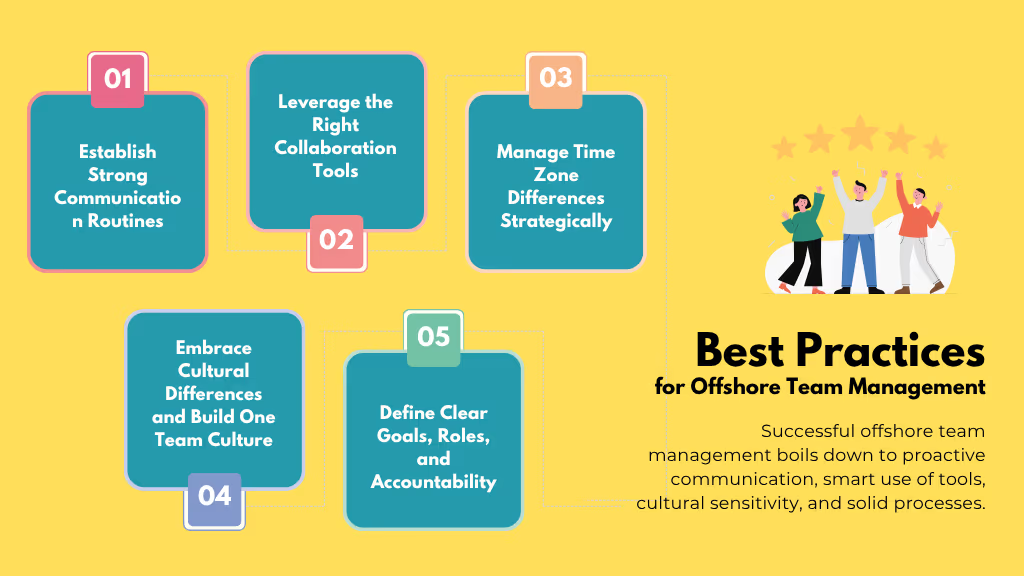
1. Establish Strong Communication Routines
Communication is king in distributed teams. As a manager, set the cadence and channels for regular interaction. Consider daily or weekly stand-up meetings via video conference to keep everyone aligned even a brief 15-minute daily check-in can work wonders for transparency.
Use a blend of synchronous communication (video/voice calls for brainstorming, sprint planning, or retrospectives) and asynchronous updates (detailed emails, project wiki updates, recorded Loom videos) to accommodate time zones.
It’s critical to set clear communication protocols: for example, decide which platform is used for what (e.g., Slack or Microsoft Teams for quick chats, email for formal approvals, Zoom for weekly team calls).
Encourage an “ask questions early” culture so offshore members feel comfortable seeking clarification instead of silently guessing. Documentation is also part of communication – maintain a centralized knowledge base or project portal where requirements, design docs, and meeting notes are stored for all to reference. This avoids confusion and keeps everyone on the same page.
Crucially, ensure overlap hours are respected. Identify a window of a few hours each day when U.S. and offshore team members are all online together and reserve that for real-time collaboration.
For instance, a U.S. East Coast manager might schedule meetings at 9–11am ET, which is end of day in India and early afternoon in Europe – a sweet spot for cross-team interactions. Outside of overlap, train the team to work asynchronously: clearly hand off tasks at end of day with written status updates so colleagues in other time zones can pick it up without delay.
2. Leverage the Right Collaboration Tools
In 2025, we’re spoiled for choice with collaboration tools for offshore teams – make good use of them. Modern project management and communication platforms effectively shrink the distance between U.S. and offshore offices. Nearly 93% of organizations have adopted cloud-based tools to streamline outsourcing coordination, underlining their importance. Here are some tool categories and top picks:
|
Tool / Platform |
Purpose |
Key Features for Offshore Teams |
|
Slack / MS Teams |
Real-time messaging & team chat |
Channels for topics, direct messaging, file sharing, integrations with other apps (JIRA, Google Drive, etc.) for unified notifications. |
|
Zoom / Google Meet |
Video conferencing |
Reliable video/audio calls, screen sharing for demos, session recording (so absent teammates can catch up), virtual whiteboards for brainstorming. |
|
Project Management (Jira, Trello, Asana) |
Task and project tracking |
Kanban/Scrum boards, assigning tasks to team members, setting deadlines, progress tracking, and notifications. Provides visibility across time zones on project status. |
|
Confluence / Google Docs |
Documentation & knowledge base |
Shared online documents and wiki pages to collaborate on specs, technical docs, meeting minutes. Edits in real-time ensure everyone sees the latest info. |
|
GitHub / GitLab / Bitbucket |
Code collaboration & version control |
Distributed version control for code, pull requests for code review, commenting for feedback. Allows asynchronous code review – U.S. leads can review code from India devs overnight, for example. |
|
Miro / Lucidchart |
Visual collaboration |
Online whiteboards and diagram tools for design discussions, architecture diagrams, process flows, accessible anytime for globally dispersed contributors. |
Make sure all team members are proficient in the chosen tools – offer training if needed. Also, be mindful of time zone settings in these tools; for example, set calendar invites to show in each participant’s local time and use scheduling assistants to find meeting times that auto-convert zones.
Encourage use of status indicators (like Slack’s “away” status or Google Calendar’s working hours) to set expectations on availability. By creating a well-integrated toolkit, you minimize friction everyone knows where to find information, update their work, and communicate issues. The result is a virtual office that’s as effective as a physical one.
Hire Vetted Offshore Developers for Any Stack
Need Java, React, Node.js, or full-stack engineers? We've got the talent. Build your remote team with experienced offshore developers who integrate seamlessly with your U.S.-based operations.
3. Manage Time Zone Differences Strategically
Instead of fighting the clock, successful managers turn time zone differences into a strength. A few strategies can help:
-
Plan Around Overlaps: As noted, identify overlapping working hours and use them for real-time collaboration. Publish a team schedule that highlights when everyone is online together. For example, if you have developers in California and testers in Eastern Europe, you might find a window in early Pacific morning that’s still late afternoon in Eastern Europe for daily sync-ups. Make it routine that critical discussions or standups happen in those overlaps.
-
Follow-the-Sun Handoffs: Structure your workflow so that work passes smoothly from one zone to the next. For instance, your U.S. team can gather requirements or do code reviews by end of their day, then your offshore developers in Asia build features while the U.S. sleeps, and finally a team in Europe does QA before the U.S. day starts. This 24-hour development cycle can cut down turnaround time for fixes and features. Document handoffs clearly – e.g., use JIRA comments or summary emails at day’s end listing what was completed and what needs attention next.
-
Flexible Schedules: Consider adjusting working hours for some team members to improve overlap. Some U.S. companies ask a portion of their offshore team to work late shifts to align more with U.S. hours, or vice versa. Be careful to rotate this burden and not always ask one side to take late-night calls – mutual flexibility builds goodwill. If occasional odd-hour meetings are necessary, rotate who has to stay up late or rise early, so it’s equitable.
-
Time Zone Tools: Leverage tools to simplify time coordination. Shared team calendars with multiple time zone display, or world-clock apps (like EveryTimeZone or Spacetime) help quickly find suitable meeting times. Even simply adding multiple clocks (Windows and Mac allow this) for the key team time zones can help managers avoid accidentally pinging someone at 3:00 AM their time.
By being mindful of time zones in planning and communication, you demonstrate respect for everyone’s working hours. This reduces burnout and frustration on offshore teams who often accommodate U.S. schedules.
Companies that treat time zone differences thoughtfully can actually gain a competitive edge, using continuous development cycles to speed up delivery while competitors sleep.
4. Embrace Cultural Differences and Build One Team Culture
Cultural differences in offshore development are real, but they need not be roadblocks – in fact, they can be catalysts for creativity. U.S. managers should invest time in understanding their offshore team members’ cultures: work ethics, communication styles, holidays, and customs.
Show genuine curiosity and respect for their traditions (for example, be aware of major festivals like Chinese New Year or Eid and send well-wishes).
Providing cross-cultural training or resources can foster mutual understanding. According to a Deloitte study, companies that invest in cross-cultural awareness see a significant improvement in team collaboration and engagement. When team members appreciate each other’s backgrounds, they collaborate more freely and avoid inadvertent offenses.
Practical steps to bridge cultures include:
-
Cultural sensitivity training: Host workshops or informal sessions where team members share about their local culture and work norms. This can clear up misconceptions (e.g., explaining why someone might say “yes” meaning “I understood” not necessarily “I agree”). Such training can improve overall team performance by 17%, as one study noted for organizations prioritizing these initiatives.
-
Celebrate diversity: Mark important cultural events for your offshore team just as you would a birthday in the office. A simple team video call to celebrate Diwali or a company-wide email recognizing your Polish developers’ celebration of Constitution Day can make people feel valued. Little gestures go a long way to build camaraderie.
-
Unified team rituals: Create shared team rituals that everyone participates in, regardless of location. This could be a virtual Friday “watercooler chat” on Zoom, a monthly all-hands meeting where achievements are recognized, or even a fun contest (like a hackathon or trivia quiz) that involves everyone. Building a shared team identity helps dissolve the “offshore vs onshore” divide. Remember, people who feel included and acknowledged are more motivated – 80% of employees say feeling appreciated makes them more engaged.
-
Appoint cultural liaisons or mentors: If you have multiple offshore locations, it can help to designate a team lead in each location who not only manages work but also acts as a cultural bridge – explaining the U.S. company’s norms to their local team and educating the U.S. side about local practices. Some companies pair up employees from different regions as “buddies” to encourage cross-cultural friendship and knowledge sharing.
By building an inclusive culture, you earn the trust and loyalty of your offshore team. They’ll feel like a true extension of your U.S. workforce rather than a contract resource.
The payoff is higher morale, lower turnover, and often more innovative ideas (diverse teams bring diverse perspectives to problem-solving). As one Forbes insight noted, companies with strong inclusive cultures had 30–50% higher retention rates, which is vital for keeping hard-to-find tech talent.
5. Define Clear Goals, Roles, and Accountability
Managing an offshore team effectively means leaving nothing important ambiguous. Set crystal-clear expectations for every project and role. From the outset, establish the project’s scope, success metrics, deadlines, and each member’s responsibilities.
Documentation of requirements should be thorough – what exactly needs to be delivered, by whom, and by when. Break projects into milestones and deliverables so progress can be measured. This clarity prevents the “I thought you meant X” problems that often plague distributed teams.
Introduce KPIs and performance metrics that apply to all team members fairly. Whether it’s number of features delivered per quarter, bug resolution time, or uptime percentages – make sure offshore team members are held to (and involved in setting) the same quality standards as your U.S. team. Regularly review these metrics together so there are no surprises about performance.
Accountability is also reinforced by having a robust project management framework. Many U.S. companies use Agile methodologies with their offshore teams – daily stand-ups, bi-weekly sprints, sprint reviews, and retrospectives. This gives frequent checkpoints to ensure accountability.
Assign ownership of specific modules or tasks to individuals or sub-teams, so everyone knows who is answerable for what. A single point of contact (like an offshore team lead) can be very helpful – they can consolidate status updates and escalate issues, making communication more streamlined.
Finally, synchronize your workflow and tools so that transparency is built-in. If using JIRA or similar, ensure tasks are updated in real-time by the offshore team. Use dashboards visible to all to track progress.
This way, if a task is slipping, it’s evident to both U.S. and offshore managers and can be corrected collaboratively, rather than erupting as a last-minute crisis.
By defining clear objectives and fostering accountability, you not only keep projects on track – you also show your offshore colleagues that their work directly ties into the company’s success. Everyone understands the importance of their contribution, which boosts motivation and alignment across oceans.
Partner With Us to Deliver Offshore Excellence
Are you a U.S.-based agency, consultant, or enterprise? Let’s collaborate. As your offshore software development partner, we’ll help you deliver scalable solutions and expand globally.
Read: Benefits of Hiring a Software Development Company
Case Study: Success Stories in Offshore Team Management
To illustrate how these best practices come together, let’s look at two real-life examples of U.S. companies working with offshore teams:
BLAZE: Offshore Development of a Complex SaaS Platform
BLAZE, based in California, provides a software suite for cannabis dispensaries, including a point-of-sale (POS) system and e-commerce marketplace. The cannabis retail industry is highly regulated and fast-evolving, so BLAZE needed a robust, secure system – essentially an ERP for dispensaries – built quickly to capture market share.
They chose to partner with an offshore development team to augment their small in-house group. The offshore team (Decipher Zone), located in India, handled a significant portion of development: backend services in Java and Dropwizard, a web frontend in React.js, and cloud infrastructure on AWS.

The offshore collaboration enabled BLAZE to develop a large and complex platform within one year, something that would likely have taken twice as long with their small local team alone. The resulting system was sophisticated yet reliable.
In fact, thanks to thorough testing and strong communication, BLAZE achieved higher productivity and quality – they reported a reduction in bugs and faster feature development compared to previous attempts with a fully local team.
The platform’s performance also benefited: the offshore team’s expertise in AWS and distributed systems architecture resulted in a scalable solution (utilizing AWS S3 for data storage and AWS SQS for queue messaging).
Top Tools & Frameworks for Offshore Team Collaboration
No offshore management guide would be complete without discussing the top collaboration tools and frameworks that make managing global teams easier. We touched on many tools earlier; here we’ll highlight how they fit into an overall management framework:
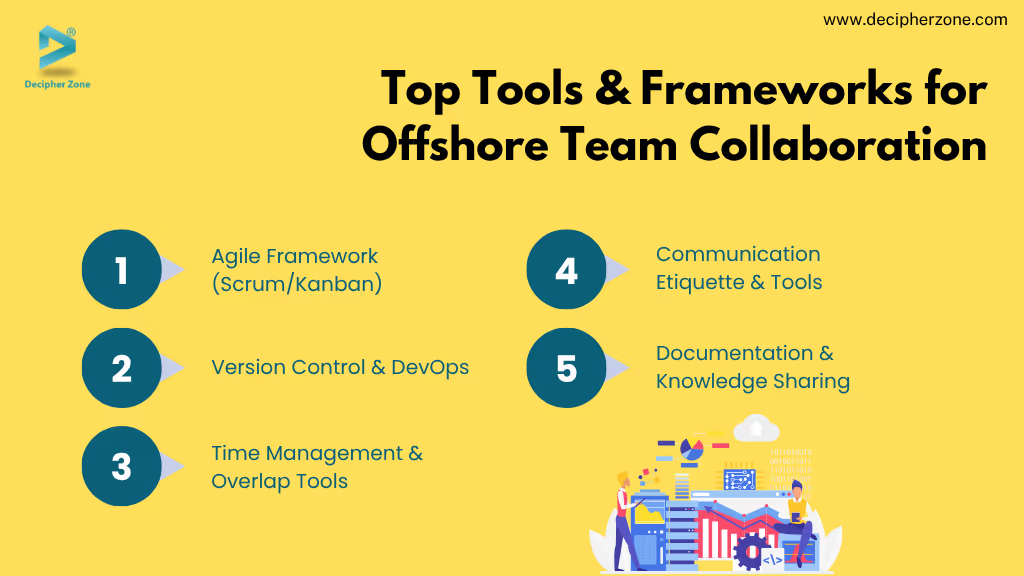
1. Agile Framework (Scrum/Kanban)
Embracing Agile methodologies is extremely effective for distributed teams. Short sprints, frequent releases, daily stand-ups, and visible task boards keep everyone focused and accountable.
Scrum, in particular, gives structure to communication (with its ceremonies) which is useful when ad-hoc hallway chats aren’t possible. Many offshore teams thrive under Agile because it provides clarity on what to do each iteration and quick feedback loops.
Make sure to adapt Agile practices to your reality – e.g., a “daily” stand-up might be 3 times a week if time zones are too far apart, or asynchronous stand-ups via Slack for some team members.
2. Version Control & DevOps
Use git-based repositories (GitHub, GitLab, Bitbucket) religiously. With a dispersed team, having a single repo where code lives ensures transparency. Pair this with a good branching strategy and continuous integration (CI) pipeline. CI/CD tools like Jenkins, CircleCI, or GitHub Actions can automatically run tests and deploy builds, which helps catch issues early no matter where the code was written. T
his automation enforces quality across borders. Additionally, containerization (Docker, Kubernetes) can help standardize development and test environments for teams oceans apart, so “it works on my machine” isn’t an issue.
3. Time Management & Overlap Tools
As mentioned, world-clock and scheduling tools are unsung heroes. Even a simple shared Google Calendar with everyone’s working hours blocked out can prevent a lot of headaches when planning meetings.
Some teams use specialized apps like Circa or World Time Buddy to visualize overlaps. Ensuring everyone is aware of time zone differences (perhaps by adding the offshore team’s time zone next to their name on Slack profiles or an internal directory) fosters empathy and smarter planning.
4. Communication Etiquette & Tools
Apart from Slack/Teams and Zoom, consider asynchronous communication enhancers. For example, recorded video updates (using tools like Loom) can substitute a live meeting and be watched by offshore colleagues later.
Project discussion threads (in tools like Basecamp or even Slack threads) keep conversations organized and accessible across time. Establish etiquette such as “reply within 24 hours to messages” so no one feels ignored across time zones, and use features like Slack’s scheduled send (to time messages to arrive in someone’s morning instead of during their off-hours).
5. Documentation & Knowledge Sharing
Wikis (Confluence, Notion) and shared drives (Google Drive, SharePoint) must be well-structured. An offshore developer should be able to find the API documentation or design spec without hunting down a person. Adopt a framework like “Docs as Code” (treating documentation like code, with version control) if your project is complex.
Also, use knowledge-sharing platforms: for instance, an internal Stack Overflow-style Q&A forum can allow team members to ask technical questions and get answers asynchronously, building a knowledge base over time.
See How We Manage Offshore Development Seamlessly
From communication tools to agile collaboration, discover how Decipher Zone ensures success across time zones, tech stacks, and cultures.
Common Mistakes to Avoid When Managing Offshore Teams from the U.S
Even well-intentioned managers can stumble into pitfalls when overseeing offshore teams. Here are some common mistakes U.S. companies should avoid:
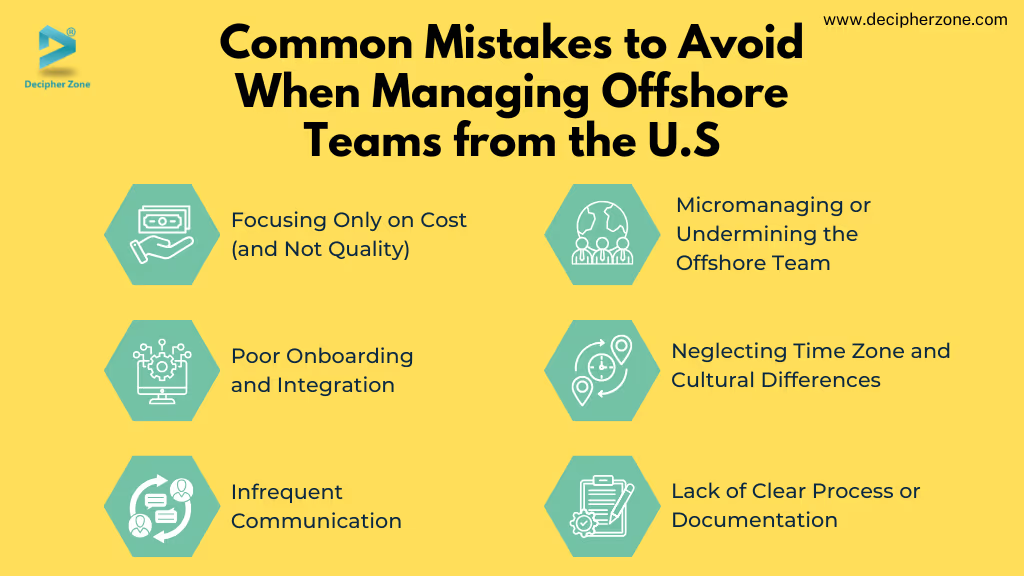
1. Focusing Only on Cost (and Not Quality)
It’s tempting to choose an offshore partner solely on low price, but rock-bottom rates can lead to subpar quality or inexperienced teams. Avoid the mistake of treating your offshore team as a cheap vendor. Instead, treat them as an extension of your team an offshore development partner.
Evaluate partners on skills, communication, and cultural fit, not just cost. Saving a few dollars per hour means nothing if the output requires extensive rework. The best U.S. companies choose offshore teams that add value, not just cut cost.
2. Poor Onboarding and Integration
A big mistake is not onboarding offshore team members with the same rigor as local hires. Don’t just toss requirements over the wall. Take the time to introduce your offshore engineers to your product vision, your company values, and key stakeholders. If they only receive technical specs without context, they’ll feel disconnected and less invested.
Also, not integrating them into team meetings or company communications (like all-hands calls) creates a silo. Include your offshore team in as many regular communications as feasible – they should hear directly about the company’s goals and successes, not just get task assignments.
3. Infrequent Communication
“No news is good news” does not apply here. Some managers make the mistake of assuming silence means all is well offshore – until a deadline arrives and work is incomplete. Conversely, others may communicate only when something is wrong, which builds a negative rapport. Avoid going long stretches without check-ins.
You don’t want your offshore team feeling abandoned or your U.S. team unaware of progress. Regular, scheduled communication (as discussed in best practices) is essential. And importantly, bridge the language gap – if something isn’t clear, don’t hesitate to double-check understanding on both sides.
4. Micromanaging or Undermining the Offshore Team
The flip side of poor communication is excessive control. Hovering over your offshore team’s every move, insisting on being CC’d on every email, or re-doing their work due to lack of trust will demoralize the team and negate the benefits of offshoring. Remember, you chose this team for their expertise – empower them.
Provide guidance and feedback, but avoid micromanaging their day-to-day. Also, resist any “us vs. them” attitudes from your onshore staff. For example, don’t let an onshore developer say “Oh, the offshore guys messed this up” – foster a one-team mentality where wins and losses are shared.
5. Neglecting Time Zone and Cultural Differences
Scheduling meetings at 3 AM local time for your offshore staff, or expecting instant answers from someone who is asleep on the other side of the world, is a fast way to ruin morale. Unfortunately, some U.S. managers do this out of ignorance or urgency. Similarly, ignoring cultural holidays or assuming everyone works U.S. hours is a mistake.
To avoid this, always check time zones before setting deadlines like “end of day” (end of whose day?). Be mindful and plan ahead to accommodate differences.
The more you respect your team’s local customs and schedules, the more they’ll go the extra mile for you. As one article put it, cultural missteps and lack of empathy can breed resentment and hurt productivity – it’s avoidable with awareness and respect.
6. Lack of Clear Process or Documentation
Another common pitfall is being too ad-hoc in managing offshore projects. Without a clear process (like Agile or a defined project plan) and proper documentation, distributed teams can quickly descend into chaos.
If your requirements are vague or constantly changing without a change management process, expect confusion. Skipping documentation to “save time” will cost more time when the offshore team delivers something unexpected. Always aim to document decisions and changes, and use a robust project management approach to keep everyone aligned.
See What We’ve Built for Global Clients
Explore how companies like Blaze and Monarch scaled faster using our offshore teams. Real-world results, trusted partnerships.
Checklist for U.S. Managers of Offshore Teams
To wrap up, here’s a handy checklist for U.S.-based managers leading offshore teams. Use this as a quick reference to ensure you’ve covered all bases in setting your team up for success:
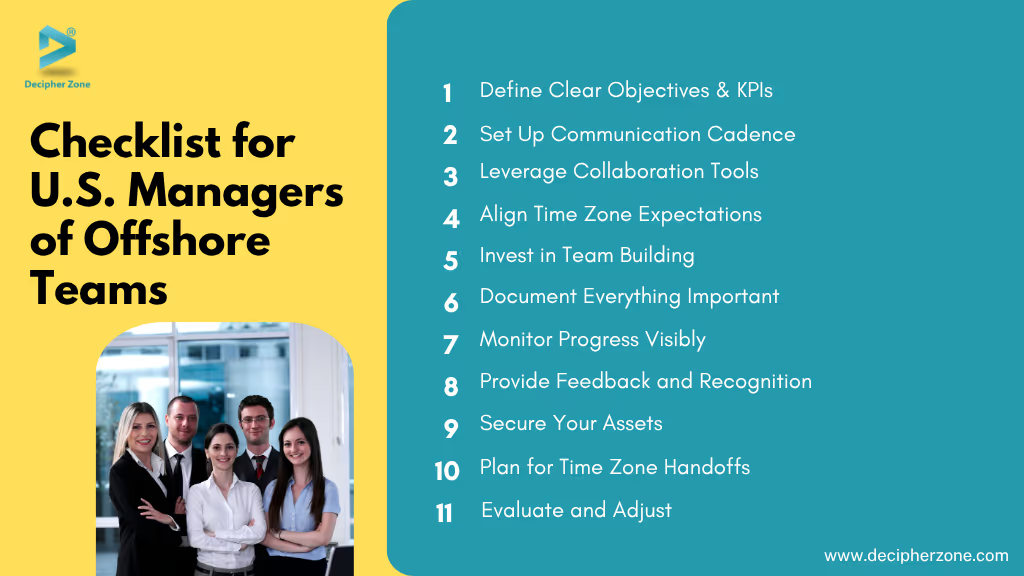
-
Define Clear Objectives & KPIs: Ensure every project has documented goals, deliverables, and success metrics understood by the whole team (onshore and offshore).
-
Set Up Communication Cadence: Schedule regular meetings (and stick to them), establish communication channels and protocols, and make sure there are overlapping hours or agreed response times for urgent queries.
-
Leverage Collaboration Tools: Equip your team with the right software (chat, video, project tracking, code repo, etc.) and verify everyone has access and training. Integrate tools where possible (e.g., link commits in Git to tasks in Jira) to create transparency.
-
Align Time Zone Expectations: Publish a working hours overlap plan, respect local holidays, and plan deliverables in a way that accounts for time differences. Avoid setting unrealistic meeting times that consistently burden one side.
-
Invest in Team Building: Conduct cultural sensitivity training, encourage informal team interactions, and make offshore members feel included. A little cultural celebration or a shared virtual coffee goes a long way to building trust.
-
Document Everything Important: From technical specifications to meeting minutes and decisions – maintain thorough documentation accessible to all. Don’t rely on verbal agreements that get lost across distances. Written clarity is the offshore manager’s best friend.
-
Monitor Progress Visibly: Use dashboards or status reports that are visible to stakeholders. Track progress on tasks and follow up quickly on blockers. This way, nothing falls through the cracks due to “out of sight, out of mind.”
-
Provide Feedback and Recognition: Offer constructive feedback frequently, not just at project end. Likewise, recognize achievements publicly (e.g., call out the offshore team’s great work in a company-wide email or meeting). Feeling valued boosts motivation for remote teams.
-
Secure Your Assets: Implement necessary security measures – NDA agreements with partners, secure VPNs, role-based access to code and data, and compliance checks. Make sure IP ownership is clearly defined in contracts with any offshore vendor. Protecting your data and code is non-negotiable.
-
Plan for Time Zone Handoffs: If leveraging multiple offshore locations, create a handoff workflow (who updates whom at end of day). Even a simple daily email or Jira update from the offshore team summarizing progress can help the U.S. team start their day informed.
-
Evaluate and Adjust: Periodically review how the offshore collaboration is going. Gather feedback from both your local team and offshore members: What’s working? What isn’t? Be willing to tweak processes, add tools, or adjust communication style. Continuous improvement will enhance the partnership over time.
This checklist can be adapted to your specific context, but it covers the fundamentals. Managing an offshore team is an ongoing learning process – staying proactive and attentive is key.
Develop World-Class Mobile Apps at Offshore Costs
Planning a mobile app but concerned about timelines or budget? Our offshore mobile development teams deliver scalable iOS, Android, and cross-platform apps—on time and on budget.
🔗 Explore Mobile App Development
Read: Pros and Cons of Nearshore Outsourcing
Conclusion
We’ve discussed how clear communication, the right tools, cultural respect, and solid project management discipline are the pillars of effective offshore team management. Real-world case studies like Monarch and BLAZE show that when done right, offshore teams can deliver high-quality results on critical projects, from fintech apps to complex enterprise software.
Whether you build your own offshore team or hire through a partner, apply the best practices you’ve learned here. With careful management, your offshore team will become one of your company’s greatest assets, driving innovation and growth around the clock.
Ready to build a high-performing offshore team? Let’s discuss how we can help you set up and manage your global development team successfully. Reach out to explore tailored offshore solutions that fit your business – and get the best of global talent working for you, without the usual headaches. Your next powerhouse team might just be an email away.
FAQs
What is the best way to manage offshore development teams?
Answer:
The best way to manage offshore development teams is to establish clear communication channels, define expectations early, and use modern project management tools like Jira or Trello. Regular check-ins, cultural awareness, and strong documentation help ensure alignment and accountability across borders.
How do U.S. companies handle time zone differences with offshore teams?
Answer:
U.S. companies manage time zone differences by scheduling overlapping working hours, using asynchronous communication tools like Slack and Confluence, and structuring workflows so progress continues round-the-clock. Some also adopt a "follow-the-sun" development model for continuous delivery.
What tools are essential for managing offshore teams effectively?
Answer:
Key tools include:
-
Slack or MS Teams for real-time communication
-
Zoom or Google Meet for virtual meetings
-
Jira, Trello, or Asana for task management
-
GitHub or Bitbucket for code collaboration
-
Confluence or Google Docs for documentation
These tools ensure seamless coordination regardless of location.
How to build trust with offshore developers?
Answer:
Trust is built through transparency, respect, and consistency. Set clear goals, provide regular feedback, recognize contributions, and encourage open communication. Including offshore teams in decision-making and team activities also boosts morale and long-term loyalty.
What are the biggest challenges in managing offshore teams?
Answer:
The most common challenges include:
-
Communication gaps due to language or time zones
-
Cultural differences affecting feedback and workflows
-
Lack of visibility into daily progress
-
Ensuring code quality and timely delivery
These can be overcome with structured onboarding, regular updates, and the right tools.
💡 Need help managing offshore development?
🚀 Build Mobile Apps | 👨💻 Hire Developers | 🌍 Scale Full-Stack Teams
Author Profile: Mahipal Nehra is the Digital Marketing Manager at Decipher Zone Technologies, specializing in SEO, content strategy, and tech-driven marketing for software development and digital transformation.
Follow us on LinkedIn or explore more insights at Decipher Zone.


.avif)